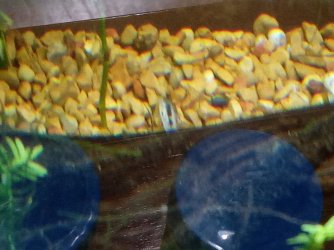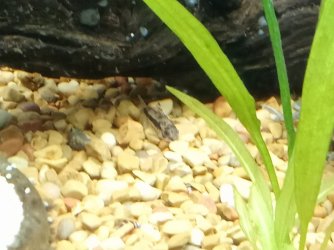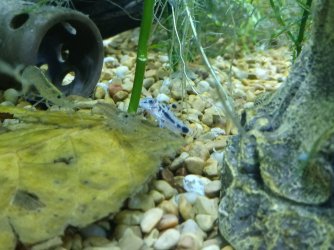JoshOfMichigan
New Member
Hello! I found one of my eight C. habrosus dead on the substrate at the back of my tank today.  About half lie on their sides frequently or swim oddly. Got them 8 months ago; they were the first fish I put in after cycling. When the strange behavior first happened a couple months ago, I removed a few to a hospital tank and dosed antibiotics. They eventually recovered enough to put back in main, and the one that seemed at death's door is now doing fine. 29g planted main tank. I keep ammonia and nitrite at 0 and nitrates under 20. pH stable at 7.5. Tankmates betta, 3 ADFs, 9 cardinal tetras, 4 amano shrimp, 6 adult assassin snails plus at least 4 assassin babies born in-tank. Cories get bottom-feeder pellets and Hikari sinking wafers. Some white (mold?) patches on driftwood and java moss - might these be toxic? If so, why would some previously sick be recovering? Too, the females are big and lazy but have never been ill. Thanks for any help you can offer!
About half lie on their sides frequently or swim oddly. Got them 8 months ago; they were the first fish I put in after cycling. When the strange behavior first happened a couple months ago, I removed a few to a hospital tank and dosed antibiotics. They eventually recovered enough to put back in main, and the one that seemed at death's door is now doing fine. 29g planted main tank. I keep ammonia and nitrite at 0 and nitrates under 20. pH stable at 7.5. Tankmates betta, 3 ADFs, 9 cardinal tetras, 4 amano shrimp, 6 adult assassin snails plus at least 4 assassin babies born in-tank. Cories get bottom-feeder pellets and Hikari sinking wafers. Some white (mold?) patches on driftwood and java moss - might these be toxic? If so, why would some previously sick be recovering? Too, the females are big and lazy but have never been ill. Thanks for any help you can offer!
 About half lie on their sides frequently or swim oddly. Got them 8 months ago; they were the first fish I put in after cycling. When the strange behavior first happened a couple months ago, I removed a few to a hospital tank and dosed antibiotics. They eventually recovered enough to put back in main, and the one that seemed at death's door is now doing fine. 29g planted main tank. I keep ammonia and nitrite at 0 and nitrates under 20. pH stable at 7.5. Tankmates betta, 3 ADFs, 9 cardinal tetras, 4 amano shrimp, 6 adult assassin snails plus at least 4 assassin babies born in-tank. Cories get bottom-feeder pellets and Hikari sinking wafers. Some white (mold?) patches on driftwood and java moss - might these be toxic? If so, why would some previously sick be recovering? Too, the females are big and lazy but have never been ill. Thanks for any help you can offer!
About half lie on their sides frequently or swim oddly. Got them 8 months ago; they were the first fish I put in after cycling. When the strange behavior first happened a couple months ago, I removed a few to a hospital tank and dosed antibiotics. They eventually recovered enough to put back in main, and the one that seemed at death's door is now doing fine. 29g planted main tank. I keep ammonia and nitrite at 0 and nitrates under 20. pH stable at 7.5. Tankmates betta, 3 ADFs, 9 cardinal tetras, 4 amano shrimp, 6 adult assassin snails plus at least 4 assassin babies born in-tank. Cories get bottom-feeder pellets and Hikari sinking wafers. Some white (mold?) patches on driftwood and java moss - might these be toxic? If so, why would some previously sick be recovering? Too, the females are big and lazy but have never been ill. Thanks for any help you can offer!






